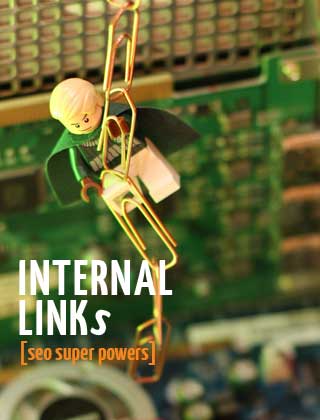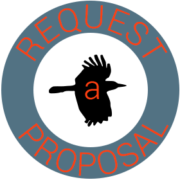Internal Links: Improve your website’s SEO
The Powerful Role of Internal Links

Does your SEO superhero reach your internal links goal?
Social Media has done wonders for many sites and brands online. From viral marketing to location-aware coupons, there’s no denying that it’s a good thing.
But Don’t Forget The SEO Super Powers of Internal Linking!
The focus on inbound links and developing strategies and relationships to bring links in from other sites is critical. So much of SEO leads to that ultimate goal. However, all of the increased interest on link building or link earning as many are now calling it, may have led some of us to neglect SEO tactics at the ground level. Despite the disruptions wrought by Panda and Penguin, Google’s significant algorithm updates, content marketing and SEO still depend on robust link structures a great deal. Internal linking in particular tends to be largely ignored, yet is an important strategy not to be taken lightly. Some go so far as to say that you can get as much SEO bang for your buck from internal links as you can from inbound links.
Anatomy of A Link
Internal links shouldn’t be overlooked as a critical component of on-site SEO, and it’s important to understand them and how to make them work for you. What exactly is an internal link? It’s simple. Unlike inbound links (links that come in-[bound] to your site from other sites) internal links are links that point to (or target) another page hosted on the same domain (i.e. another page on your site).
Why Internal Linking Yields Results
You’ve heard the terms, “site architecture” “site navigation”. Google has been upfront about the importance of link architecture in their official communications with us -the general public. The benefits of a clear-cut, transparent, simple and straightforward internal linking structure are tremendous. A solid internal linking structure helps to establish the hierarchy of information on your site. Internal links also provide a way for your visitors to navigate your website increasing user experience and satisfaction (avoiding user frustration) and demonstrating value to Google.
An SEO-Friendly Architecture is A Must.
To create internal links in a manner that gives your content a boost in the SERPs, start by sketching out a map of your entire site- a Site Map (if you don’t already have one to work with from when your site was first created). This will give you a picture of the basic main structure of the site. Imagine trying to build a house without a blue print and then trying to build on to it with a new wing. Impossible, right? It’s the same with websites. Mapping out the architecture will help you to create a logical navigation strategy. We like to use the good, old-fashioned tried and true elementary school style outline for this, with tabs indicating the navigation structure. From there, you can begin to understand and see where your internal links will make sense. Make it easy for your user to get to where they’re going.
Links Need to Be Found
In order to be of any value in SEO terms, internal links must be crawled/indexed by Google’s search engine spiders. You need to make it easy for Google. A big part of having an easily-indexed site structure is including an XML sitemap and having an HTML sitemap in the root directory of a website. Your web developer will take care of this, so you don’t need to worry about the “how”, but you can check with them to make sure it’s in the plan. Above and beyond sitemaps (more about site maps later and where you can participate directly in their creation) internal links help search engines to more clearly define link structures and index a site’s high-quality content.
Link Strategies & Tools of The Trade
The initial step in bolstering internal links that go beyond the main site navigation for SEO purposes is to ascertain which pages on your domain have high value in the eyes of the search engines. This can be accomplished quite easily with tools like Open Site Explorer and the MozBar. They’ll give you key insights into things like PageRank (Google’s way of telling us how important a page is on the web), in-bound links and etc. for any page.
Once you’ve identified your winners, you can link from high-ranking pages to those with less perceived strength to boost the overall quality of any site as whole and increase rankings for pages revolving around important keywords. Spread the love.
This gives you a way to promote the healthy flow of link juice from stronger to weaker pages, strengthening the site as a whole in the organic search rankings. Internal links spread the link juice around the site. Link juice is ranking power. Letting that power spread throughout your site assists each page in gaining ranking potential.
Tips, Tricks and Best Practices
Let’s start off with what should be avoided when crafting internal links. Most important of all, don’t just insert links from one page to another without considering relevance and context. A major benefit of internal links is that they keep traffic on your site and reduce bounce rates when used correctly. So your links should lead to content that visitors will not only find helpful or informative based on what they happen to be reading at the moment that will lead them there, but also what they expect to find when they click the link. There needs to be relevancy with an intentional logic behind it.
Using descriptive keywords as anchor text is crucial. In addition, make sure that your anchor text keywords match the content found on the target page. Do not use “click here”. Prominently positioning links to your most popular blog posts on your home page isn’t a bad idea, either.
Any page you link to from your Home page sends a strong signal of trust that you place high value on the page you are linking to. This is good. Think of it as a kind of family line, a passing down of good traits from older, wiser members of the family to the children, grandchildren, great grandchildren who inherit their strengths and who need help and support to grow. Geez. I know, that’s pretty corny, but the general concept works.
One of the easiest ways to create links is to add a list of related links at the end of a landing page or in the sidebar. Breadcrumbs, related post links and categories in your blog also work well as internal links.
“A link is a vote”. To quote Brian Whalley in a post on Hubspot in February 2012: “If you’ve heard that inbound links are like other sites voting for your content and telling search engines what your content is about, internal links are like voting for yourself and also letting the search engine know about your vote.”
Getting Your Act Together – Better Late Than Never
If you haven’t been implementing an active internal linking strategy, it’s not too late to get started. You can breathe new life into an existing site with a bit of effort.





